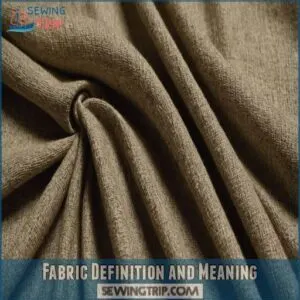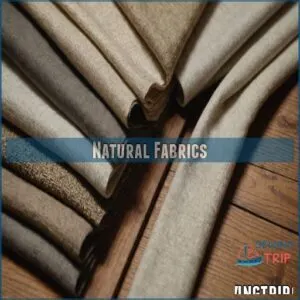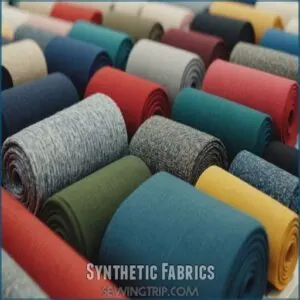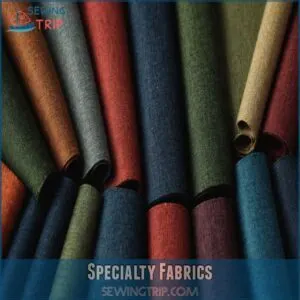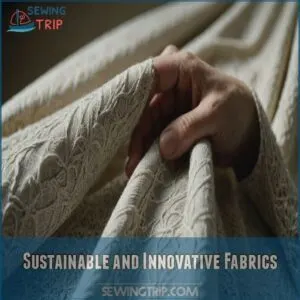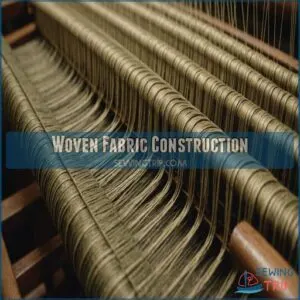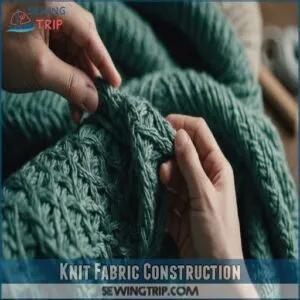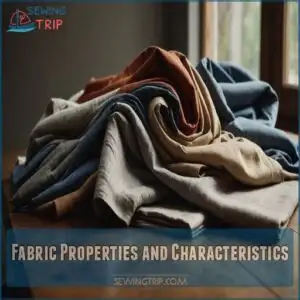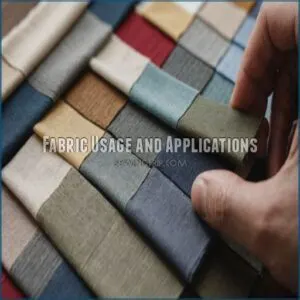This site is supported by our readers. We may earn a commission, at no cost to you, if you purchase through links.
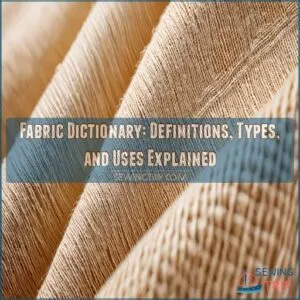
Imagine fabric as a sophisticated storyteller, whether it’s woven, knitted, or felted.
Fabrics come from plants, animals, and even synthetic sources, each with its unique texture and quality.
You might find cotton cool and cozy, like your favorite T-shirt, while silk whispers luxury.
This dictionary guides you through types like natural, synthetic, and innovative sustainable options.
It’s not just about aesthetics—think clothing, upholstery, and beyond.
Curious how these materials weave into everyday life?
There’s much more to explore!
Table Of Contents
Key Takeaways
- You’ll find that fabric is more than just cloth; it underpins both tangible items like clothing and metaphorically represents the structure of societies.
- Understanding fabric terminology, such as weaves and finishes, enhances your ability to navigate textile options effectively, aiding in both selection and application.
- Different fabric types, whether natural, synthetic, or sustainable, offer unique benefits and limitations, informing your decisions for clothing or upholstery.
- Innovations like sustainable materials and smart textiles are transforming the industry, promoting durability and eco-friendliness to align with modern values.
Fabric Definition and Meaning
When you hear the word ‘fabric,’ you’re probably thinking about the cloth used for making your favorite shirt or sofa cover.
It’s fascinating to realize that this term also weaves its way into describing the underlying structure of societies and systems, holding everything together just like a well-crafted quilt.
Dictionary Definition of Fabric
Ever wonder what fabric really is?
At its core, fabric is a versatile material that comes in various forms, such as tightly woven cotton or linen suitable for sewing coiled baskets, and it’s the backbone of clothing, upholstery, and beyond.
The term "fabric" shares its roots with "textiles" and "material," jazzing up everything from fibers to weaving.
Historically, cloth has wrapped humanity’s stories for millennia, dressing both people and ideas alike.
Fabric Terminology and Language
You’ll find understanding fabrics easier with a little fabric glossary knowledge.
Understanding fabric slang, like "selvedge" (the finished edge of fabric) or textile jargon such as "wale" (a vertical rib in fabric), helps.
Knowing common phrases like "fabric weight" (how heavy a fabric is) is key, and understanding sewing terminology, such as the importance of grain line and selvage edge, can make a big difference in your sewing projects learn more about sewing terminology.
This fabric identification guide will help you understand fabric names and types, including the various transparent fabric types names used in fashion for their delicate and lightweight construction. This fabric identification guide will help you understand fabric names and types.
A fabric glossary opens up a whole new world of textile understanding!
Etymology of The Word Fabric
Fabric’s roots stretch back to Latin origins, where "fabrica" referred to skillful workmanship.
Imagine this rich history influencing today’s language and giving rise to various uses in textiles and weaving.
Here’s how it unraveled:
- From Latin "fabrica" meaning workshop or craft.
- Old French adapted it as "fabrique."
- English refined it to "fabric.
Fabric in Different Contexts
Fabric isn’t just material—it’s woven into our lives, from clothing to technological wonders.
Historically, it shaped civilizations, while in art, it paints vivid cultures.
Just like training a dog with a professional guide like Professional Dog Trainer can lead to a more harmonious pet-owner relationship, the right fabric choices can lead to a more harmonious balance between style and functionality.
Sustainable textiles now lead the charge for a greener future.
Whether it’s the high-tech fibers in sports gear, fabric or the heavy-duty canvas for outdoor gear, fabric threads through every facet of life, subtly shaping our world.
Types of Fabrics
When choosing fabric, you’ll encounter various sheer options, such as types of sheer fabric, which include natural fibers like silk and cotton, and synthetic fibers like polyester and nylon. When choosing fabric, you’ll encounter a diverse world from natural types like cotton and wool to cutting-edge sustainable options.
Understanding these categories helps you select the right material for everything from comfy clothes to eco-friendly innovations.
Natural Fabrics
When you think of textiles, natural fibers like wool are often considered warmer and more durable than cotton due to wool’s superior insulation properties. Natural fibers like cotton, linen, and silk probably spring to mind.
These eco-friendly options, including sustainable fabric options like organic cotton and hemp that offer pesticide-free comfort and durability, have been leading the way in sustainable fabric options for clothing. These eco-friendly options have been woven into the fabric of textile history, prized for their comfort and breathability.
With growing trends in fabric sourcing, these staples remain at the forefront, appealing to those seeking both sustainability and style without compromising on quality.
Synthetic Fabrics
Synthetic fabrics, crafted from man-made fibers, offer versatility and performance unmatched by naturals.
Originally born in labs, these textiles like polyester, nylon, and acrylic have woven themselves into everyday lives.
While care is a breeze, recycling remains essential to reduce environmental impact.
For the eco-conscious, exploring alternatives to traditional synthetics might just weave a new chapter in sustainability.
Specialty Fabrics
Stepping beyond synthetic wonders, the realm of specialty fabrics is where technical textiles and high-performance fabrics shine.
Picture materials engineered for extreme conditions or specific uses, like flame-retardant suits or moisture-wicking sportswear.
These specialty fibers showcase innovation with unique fabric compositions and properties, offering solutions that push boundaries and redefine what’s possible.
It’s fabric science turned up to eleven!
Sustainable and Innovative Fabrics
How are you thinking about fashion’s future?
Sustainable and innovative fabrics are changing the game!
They’re kinder to the planet and offer amazing performance.
- Bio-based materials, like Tencel, are booming.
- Recycled fibers give old clothes new life.
- Textile waste is being cleverly repurposed.
- Circular fashion is the new black.
- Future fabrics are ecofriendly and biodegradable.
These innovations offer a brighter future for fashion.
Fabric Structure and Properties
You’re about to unravel the fascinating world of fabric structure, from the intricate weaves of a basket to the cozy feel of a knit sweater.
Understanding fabric properties, like elasticity and strength, can help you pick materials that won’t leave you shivering when your sweater decides to shrink unexpectedly.
Woven Fabric Construction
You’re stepping into the fascinating world of woven fabric construction, where timeless craft meets modern needs.
Woven fabric patterns, like houndstooth and twill, add texture and character.
Each weave variation impacts the fabric’s weight and feel, from lightweight baskets to sturdy twills.
For a deeper look into the various woven fabric types and their applications, explore woven fabric types.
These historical weaves create durable, versatile textiles, forming the backbone of fabric types used in clothing and beyond.
Knit Fabric Construction
Knit fabric construction, unlike weaving, uses loops of yarn to create a textile full of flexibility and comfort.
Imagine: from jersey knits to rib knits, various knit fabrics offer a wide range of properties and applications.
- Stretch: Think cozy sweaters that give like a stretchy yoga pose.
- Durability: Built like a trusty old pair of socks, enduring wear.
- Breathability: Like your skin enjoying a gentle breeze.
- Versatility: Perfect from t-shirts to socks, knitting works wonders.
Fabric Finishes and Treatments
Ever felt your favorite shirt getting a makeover? That’s fabric finishes and treatments working their magic.
These processes add flair and durability to textiles.
Whether it’s through Eco-Friendly Treatments or exciting Surface Effects, these techniques enhance your fabrics.
| Finish Type | Purpose |
|---|---|
| Cire | Glossy finish |
| Embossed | Texture |
| Flocked | Velvet feel |
| Napped | Softness |
| Durable Finishes | Longevity |
Try unmasking these treatments next time you’re fabric shopping!
Fabric Properties and Characteristics
Fabric properties and characteristics bring out its personality, from its texture to how it drapes.
Like choosing friends, fabrics differ in strength and comfort.
Here’s a quick rundown:
- Fabric Weight: Light as a feather or heavy like a security blanket.
- Drape: How it elegantly flows or holds stiff.
- Durability: Toughness in the face of wear.
- Breathability: Keeps you cool in the heat.
Fabric Usage and Applications
In exploring various textile uses, understanding fiber content and stretch can help you choose the right fabric for your projects. In exploring fabric usage and applications, you’ll notice fabrics aren’t just for sewing clothes but also serve important roles in upholstery, industry, and art.
Think of fabric as the versatile actor that plays the lead in apparel, the supporting role in furniture, and even cameo appearances in technical and creative projects.
Clothing and Apparel
Explore the realm of clothing and apparel!
From everyday tees to haute couture gowns, fabric choices drive fashion history.
Consider the drape of silk versus the durability of denim, and for a better understanding, refer to a fabric types chartFabric Types Chart to explore the various properties of fabrics.
Understanding fabric properties—like breathability and stretch—is key to clothing care.
Explore fabric trends and textile innovation to create your perfect look.
Apparel design hinges on selecting the right materials.
Let’s explore the amazing versatility of fabric!
Furniture and Upholstery
When you’re picking fabric for furniture, durability is key.
Consider trends in pattern and texture that match your vibe.
Cleaning should be a breeze, right? Look for weaves that hide stains and offer easy maintenance.
Sustainability matters too; opt for eco-friendly options when possible.
You’ll find that with the right choices, your space feels both stylish and practical.
Industrial and Technical Textiles
Think beyond your couch to industries like construction and aerospace—you’ll encounter industrial and technical textiles.
These performance fabrics pop up in surprising places, from fire-resistant uniforms to automotive upholstery.
Technical applications transform everyday materials into superheroes of strength and durability.
Textile innovation means they can stand up to harsh environments, keeping safety and efficiency top of mind in industrial design.
Artistic and Creative Uses
Industrial textiles have their business side, but let’s shake things up with fabric art.
Picture textile design as a canvas for creativity.
Fashion illustration adds flair, while upcycling breathes new life into old threads.
Mix media like a mad artist, turning patterns and designs into art.
Textile creativity is a kaleidoscope of innovation.
Frequently Asked Questions (FAQs)
What is the definition of fabric in the dictionary?
Fabric is a woven or knitted material used for making clothes, covering furniture, and creating various items. It’s metaphorically the structure holding society together, symbolizing its foundational aspects and interconnectedness.
What is the meaning of fabric in Oxford dictionary?
You’ll find "fabric" defined in the Oxford Dictionary as a woven material, typically used for clothing.
It also means the underlying structure of something, like "the fabric of society."
Pretty versatile word, huh?
What is fabric terminology?
Crafting fabric terminology involves understanding weaves, fibers, and finishes.
Imagine unraveling a tapestry of technical terms like "basket weave," "jersey knit," and "bio lycra."
It’s the fabric of language, defining textures, trends, and technology.
What is the textile dictionary?
A textile dictionary is a thorough guide offering definitions and explanations for terms and processes in the textile industry.
It covers fabric types, weaving methods, dyeing techniques, and fiber characteristics.
This helps you navigate the complex textile world.
How does fabric impact the environment?
Your choice of fabric can greatly impact the environment; consider the production process, material sourcing, and end-of-life disposal when selecting fabrics to reduce waste, conserve resources, and minimize ecological footprint.
What are common fabric manufacturing processes?
Imagine weaving a tapestry of innovation—fabric manufacturing processes include spinning fibers into yarn, weaving or knitting into cloth, and applying finishes.
These steps transform raw materials into the diverse, textured fabrics that color our lives.
How do fabric finishes affect durability?
Fabric finishes, like waterproofing or dyeing, can boost or hinder durability.
Some add strength, while others weaken fibers.
It all depends on the finish and the fabric itself.
Understanding this helps you choose wisely.
What innovations are shaping the fabric industry?
Emerging innovations like sustainable materials, smart textiles with embedded technology, and advanced, eco-friendly dyeing processes are reshaping the fabric industry.
These trends enhance durability and functionality while addressing environmental concerns, aligning with modern consumer values.
How do cultural traditions influence fabric design?
Patterns mirror heritage, symbols tell stories, and colors reflect beliefs.
Cultural traditions shape fabric design by weaving history into every thread.
Think of batik from Indonesia or tartans from Scotland—each piece is a cultural narrative.
Conclusion
Just as a thrilling novel keeps you on the edge of your seat, a fabric dictionary offers endless stories about textures and origins, sparking your creativity.
Whether you’re choosing cotton for comfort or exploring the vast range of sustainable textiles, understanding fabric can transform everyday choices.
Remember, each fabric type serves a unique purpose but also plays a part in our daily narrative.
So, next time you pick up a shirt or a chair, let the fabric dictionary guide you.

